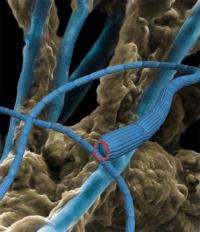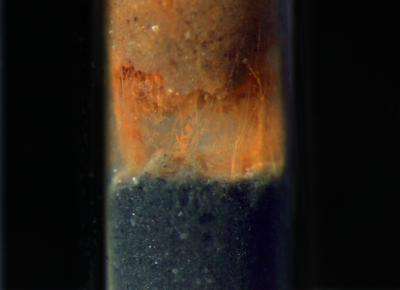Live cables explain enigmatic electric currents

Researchers at Aarhus University, Denmark, made a sensational discovery almost three years ago when they measured electric currents in the seabed. It was unclear as to what was conducting the current, but the researchers imagined the electric currents might run between different bacteria via a joint external wiring network.The researchers have now solved the mystery. It turns out that the whole process takes place inside bacteria that are one centimetre long. They make up a kind of live electric cable that no one had ever imagined existed. Each one of these 'cable bacteria' contains a bundle of insulated wires that conduct an electric current from one end to the other.
Cable bacteria explain electric currents in the seabed
Electricity and seawater are usually a bad mix. And it was thus a very big surprise when scientists from Aarhus University a few years ago discovered electric currents between biological processes in the seabed. Since then they have been searching for an explanation and together with partners from the University of Southern California, USA, they now present sensational results in Nature.
"Our experiments showed that the electric connections in the seabed must be solid structures built by bacteria," says PhD student Christian Pfeffer, Aarhus University.
He could interrupt the electric currents by pulling a thin wire horizontally through the seafloor. Just as when an excavator cuts our electric cables.
In microscopes, scientists found a hitherto unknown type of long, multi-cellular bacteria that was always present when scientists measured the electric currents.

"The incredible idea that these bacteria should be electric cables really fell into place when, inside the bacteria, we saw wire-like strings enclosed by a membrane," says Nils Risgaard-Petersen, Aarhus University. Kilometers of living cables
The bacterium is one hundred times thinner than a hair and the whole bacterium functions as an electric cable with a number of insulated wires within it. Quite similar to the electric cables we know from our daily lives.
"Such unique insulated biological wires seem simple but with incredible complexity at nanoscale," says PhD student Jie Song, Aarhus University, who used nanotools to map the electrical properties of the cable bacteria.
In an undisturbed seabed more than tens of thousands kilometers cable bacteria live under a single square meter seabed. The ability to conduct an electric current gives cable bacteria such large benefits that it conquers much of the energy from decomposition processes in the seabed.
Unlike all other known forms of life, cable bacteria maintain an efficient combustion down in the oxygen-free part of the seabed. It only requires that one end of the individual reaches the oxygen which the seawater provides to the top millimeters of the seabed. The combustion is a transfer of the electrons of the food to oxygen which the bacterial inner wires manage over centimeter-long distances. However, small disturbances can lead to fatal "cable breakage" in the fragile bacteria.
Biological innovation
"On the one hand, it is still very unreal and fantastic. On the other hand, it is also very tangible," says Professor at Aarhus University, Lars Peter Nielsen, who is in charge of exploring the natural electrical currents.
Along with a number of international cooperation partners, several scientists at Aarhus University already address the new and exciting questions that arise. Right from the understanding of bioelectronics at the molecular level to the role of cable bacteria in the history of Earth.
The future will tell whether this wondrous result of the biological evolution can also be used in new types of electronics.
More information: Nature DOI:10.1038/nature11586
Journal information: Nature
Provided by Aarhus University


















